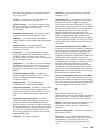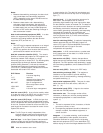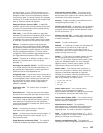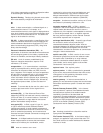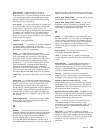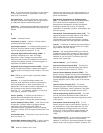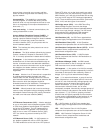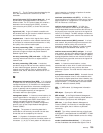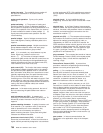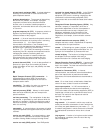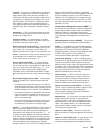LES. LAN Emulation Server. A LAN Emulation Service
component that resolves LAN Destinations to ATM
Addresses.
line switching. Synonym for
circuit switching
.
link. The combination of the link connection (the
transmission medium) and two link stations, one at each
end of the link connection. A link connection can be
shared among multiple links in a multipoint or token-ring
configuration.
link access protocol balanced (LAPB). A protocol
used for accessing an X.25 network at the link level.
LAPB is a duplex, asynchronous, symmetric protocol,
used in point-to-point communication.
link-attached. (1) Pertaining to devices that are
connected to a controlling unit by a data link. (2)
Contrast with
channel-attached
. (3) Synonymous with
remote
.
link connection. (1) The physical equipment providing
two-way communication between one link station and
one or more other link stations; for example, a
telecommunication line and data circuit-terminating
equipment (DCE). (2) In SNA, synonymous with
data
circuit
.
link level. (1) A part of Recommendation X.25 that
defines the link protocol used to get data into and out of
the network across the full-duplex link connecting the
subscriber’s machine to the network node. LAP and
LAPB are the link access protocols recommended by
the CCITT. (2) See
data link level
.
link-state. In routing protocols, the advertised
information about the usable interfaces and reachable
neighbors of a router or network. The protocol’s
topological database is formed from the collected
link-state advertisements.
link station. (1) The hardware and software
components within a node representing a connection to
an adjacent node over a specific link. For example, if
node A is the primary end of a multipoint line that
connects to three adjacent nodes, node A will have
three link stations representing the connections to the
adjacent nodes. (2) See also
adjacent link station (ALS)
.
local. (1) Pertaining to a device accessed directly
without use of a telecommunication line. (2) Contrast
with
remote
. (3) Synonym for
channel-attached
.
local area network (LAN). (1) A computer network
located on a user’s premises within a limited
geographical area. Communication within a local area
network is not subject to external regulations; however,
communication across the LAN boundary may be
subject to some form of regulation. (T) (2) A network
in which a set of devices are connected to one another
for communication and that can be connected to a
larger network. (3) See also
Ethernet
and
token ring
. (4)
Contrast with
metropolitan area network (MAN)
and
wide area network (WAN)
.
local bridging. A function of a bridge program that
allows a single bridge to connect multiple LAN
segments without using a telecommunication link.
Contrast with
remote bridging
.
local management interface (LMI). See
local
management interface (LMI) protocol
.
local management interface (LMI) protocol. In NCP,
a set of frame-relay network management procedures
and messages used by adjacent frame-relay nodes to
exchange line status information over DLCI X'00'. NCP
supports both the American National Standards Institute
(ANSI) and International Telegraph and Telephone
Consultative Committee (ITU-T/CCITT) versions of LMI
protocol. These standards refer to LMI protocol as
link
integrity verification tests (LIVT)
.
locally administered address. In a local area
network, an adapter address that the user can assign to
override the universally administered address. Contrast
with
universally administered address
.
logical channel. In packet mode operation, a sending
channel and a receiving channel that together are used
to send and receive data over a data link at the same
time. Several logical channels can be established on the
same data link by interleaving the transmission of
packets.
logical link. A pair of link stations, one in each of two
adjacent nodes, and their underlying link connection,
providing a single link-layer connection between the two
nodes. Multiple logical links can be distinguished while
they share the use of the same physical media
connecting two nodes. Examples are 802.2 logical links
used on local area network (LAN) facilities and LAP E
logical links on the same point-to-point physical link
between two nodes. The term logical link also includes
the multiple X.25 logical channels that share the use of
the access link from a DTE to an X.25 network.
logical link control (LLC). The data link control (DLC)
LAN sublayer that provides two types of DLC operation
for the orderly exchange of information. The first type is
connectionless service, which allows information to be
sent and received without establishing a link. The LLC
sublayer does not perform error recovery or flow control
for connectionless service. The second type is
connection-oriented service, which requires establishing
a link prior to the exchange of information.
Connection-oriented service provides sequenced
information transfer, flow control, and error recovery.
logical link control (LLC) protocol. In a local area
network, the protocol that governs the exchange of
transmission frames between data stations
independently of how the transmission medium is
702 MRS V3.2 Software User’s Guide




